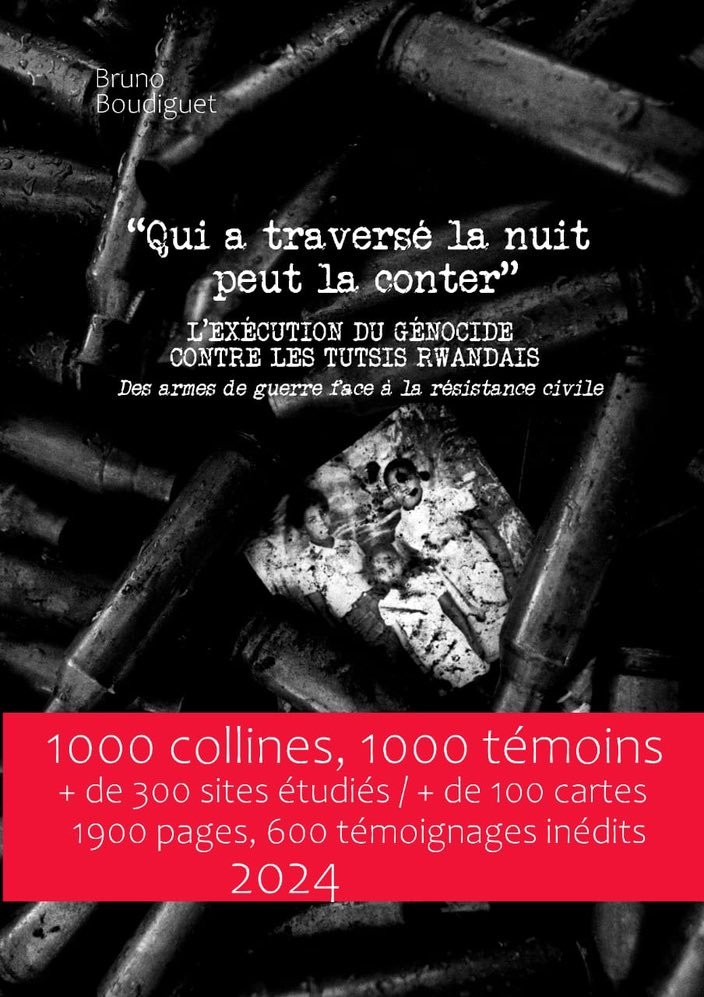
The author Bruno Boudiguet
Days before the 30th Commemoration of the Genocide against the Tutsi in Rwanda, author Bruno Boudiguet (B.B.) presents his third book “Who has crossed the night can tell it” a-1,900 page volume focusing on the Genocide against the Tutsi. He talked to Rwanda News Agency’s André Gakwaya.
Boudiguet has also authored; “Françafrique 2012, the time bomb” Aviso, 2012; “Friday the 13th in Bisesero”, Aviso, 2014; “The genocide of the Tutsi in Kibagabaga. A trampled memory.” Izuba, to be published in 2024. Read the interview below:
RNA – Can you tell us about your upcoming new book on the genocide perpetrated against the Tutsi, titled “He Who Has Crossed the Night Can Tell It”?
B.B. – My last book dated from 2014, so it took me ten years to produce the next one, but this is a much larger volume, corresponding to approximately 18 works in number of characters, and contains 1900 pages in A4 format. Started in 2012, it is finished and currently being edited. This is almost the first* global study of the execution of the genocide of Rwandan Tutsi in 1994. It will first be published in french.
RNA – Can you tell us about the genesis of your book?
B.B. – From previous investigations, I realized the importance of weapons of war in the extermination process in Kibuye prefecture. This gave me the idea to investigate other prefectures, starting in 2012-2013. But the bulk of the field investigation took place in 2022-2023, where I obtained authorization from Minubumwe, the National Scientific and Technical Council (requiring the approval of two university deans) as well as the Committee of ethics dependent on the Ministry of Health. We have established, with the latter organization, a protocol for interviews with survivors, so that they feel confident in the sometimes difficult process of delivering testimonies.
RNA – What areas does your study cover?
B.B. – I reviewed the 130 former communes of the then government zone, and tried to document 300 sites where mass massacres of the genocide took place by interviewing 600 witnesses (95% of the survivors) and citing 400 others. public testimonies.
This work is embellished with more than a hundred maps, that is to say one map per commune, containing both sectors and cells of yesteryear, as well as maps of Kigali, Butare, Kabgayi and Gisenyi. On these maps are superimposed the old administrative structure created after independence and the new one, resulting from the 2006 reform. The main sites of the genocide are of course indicated. I have also inserted more than 400 photos of sites and memorials, and when you look through it all, it immediately gives you an idea of the scale of the tragedy that occured.
RNA – What new features are proposed in your book?
B.B. – A large number of sites almost absent from the bibliography on the subject are documented, with a focus on the weapons of war used during the massacres, how they were decisive, as the civil resistance of the Tutsi was so important and effective. Machetes and other clubs have always been at the center of stories, but who has heard of helicopters, hill bombings, machine guns and other heavy weapons, in addition to Kalashnikovs and grenades? The heart of this work is also the testimonies, rarely reproduced for the benefit of summaries, hence the title ‘Who has crossed the night can tell it’.In the conclusion, I present data and statistics never before produced on this state crime, one of the most important of the 20th century.
RNA – When will we be able to purchase your book?
B.B. – The release date is not yet known, even if it will undoubtedly be this year (publishing times are much longer than those of journalism), but I can already, in addition to the experience I have had during the production of this work, expose the results of my research work during this 30th commemoration. I am also preparing an article/file for April 7, intended to be both didactic, impactful and a summary of the good pages of this book.
RNA – Your study does of course not start from scratch. What existing works did you draw on?
B.B. – The “Rousseau report” as it is commonly called, the first overview of the massacres with the goal to identify the needs for memorials, published in February 1996, was one of the common threads of this investigation. The African Rights study published in 1994/1995 was already very extensive (1,200 pages) and the FIDH/Human Rights Watch report, which is still authoritative, demonstrates the mechanics of the genocide, the political responsibilities, by focusing more on three sites. Finally, the CNLG (which has since become MINUBUMWE), in a work on the preparation and execution of the genocide perpetrated against the Tutsi, presents previously unpublished and chronological summaries of a very large number of sites. This work is the most cited in my book, because the team led by the Minister of National Unity and Civic Engagement, Dr. Jean-Damascene Bizimana, carried out long-term work on a very large number of of sites of the genocide perpetrated against the Tutsi, thanks in particular to a strong regional network.
I would also like to salute the entire local administration (districts, sectors, cells) who, in addition to their warm welcome, have greatly facilitated my task, sometimes by giving me space in their offices so that the survivors can feel confident during interviews.
RNA – What about survivor associations? Was there any collaboration with them?
B.B. – I mainly worked with the district presidents of Ibuka, who have essential knowledge of the terrain and to whom I submitted ideas for sites that I already knew. They were very helpful. I witnessed, during the investigation, the renewal of generations within this association, a very important handover in order to perpetuate this association which fights for the memory of this genocide and for the well-being of people survivors. I also, among others, worked with Josiane Umulisa, from GAERG, who runs numerous workshops with survivors, in a large number of districts, without forgetting Ignatiana Mukarusanga, an academic and psychologist now retired. (End)
 The cover of the book
The cover of the book
